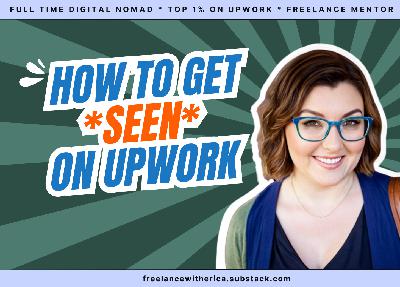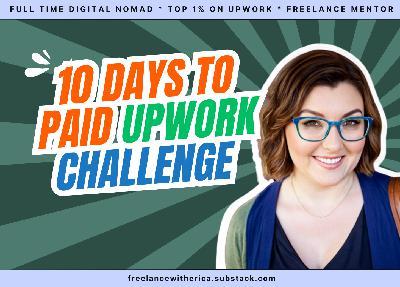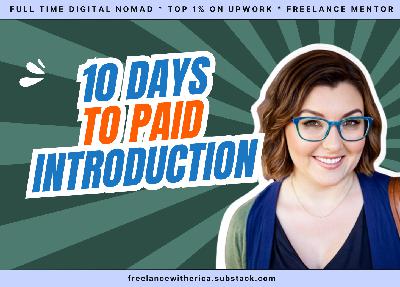Should You Offer Hourly, Project-Based, or Packages as a Beginner Freelancer?
Description
Hey there, future freelancer! 👋
If you're sitting there frantically googling "how much should I charge for [insert the freelance service of your choice]" while simultaneously having an existential crisis about whether you're even qualified to charge ANYTHING...
First of all, deep breath. Put down the Diet Coke.
(Just kidding, *never* put down the Diet Coke.)
Second, I'm about to make this SO much simpler than all those "charge what you're worth!" posts or “it’s an energy exchange” advice. (Your “worth” is defined by SO MUCH MORE than what labor you can perform for other people and their businesses, FYI.)
Because here's the thing—as a beginner, you've got exactly ONE goal:
Build momentum and credibility. FAST. 🚀
And the pricing model you choose can either rocket you toward success or leave you stuck in proposal purgatory forever. (Spoiler: I spent too much time in proposal purgatory. It sucked. Learn from my mistakes.)
Quick Announcement Before We Dive In
If you're new here, I just wrapped up creating 10 Days to Paid—my Upwork course for freelance beginners that takes you from "what would I even offer as a freelancer?" to landing your first paying client.
It includes:
🎯 Exactly what service to offer (even if you think you have no skills)📝 Word-for-word proposal templates that actually work💰 My proven pricing strategy (what we're diving into today!)🚀 How to get clients WITHOUT a portfolio
Grab it now if you haven't already. Because today's training is going to make a LOT more sense if you understand the bigger picture of beginner freelancing.
Now, back to our regularly scheduled training on the pricing panic most new freelancers face... 😅
My Embarrassing Pricing Journey (So You Don't Have To Repeat It)
When I first started freelancing, I did what any reasonable completely panicked person would do: I made up random numbers and hoped for the best.
My thought process went something like:
* "Well, I made $50/hour at my corporate job..." 💭
* "But I have no experience..." 😰
* "But I'm really smart!" 🧠
* "But no one knows that..." 😭
* "Maybe I'll charge $75 because…confidence?" 💪
* Sends zero proposals because paralyzed by fear 🫠
Plot twist: NONE of that mattered because I was doing it ALL wrong.
If you're new to freelancing and wondering how the hell to price your work—hourly? flat fee? packages? retainers? blood sacrifice to the freelance gods?—I'm gonna make this REAL simple for you.
The Pricing Strategy That Actually Works for Beginners 💰
1. Start With Hourly Pricing (Yes, Even If It Feels "Beneath" You)
I know, I know. You're thinking:
"But Erica, I have 10 years of experience!" 😤
"But Erica, I have a masters degree!" 🎓
"But Erica, hourly pricing is for BEGINNERS!" 🙄
To which I lovingly respond: YOU ARE A BEGINNER. (At freelancing, anyway.)
Sips her Diet Coke aggressively 🥤
Here's the uncomfortable truth: As a beginner freelancer, your rate is one of the ONLY levers you can pull to compete.
You don't have:
* ⭐ Shiny 5-star reviews
* 📊 Impressive job history
* 💬 Glowing testimonials
* 🏆 That fancy "Top Rated" badge
* 🦄 A magical portfolio that makes clients JUMP to work with you
So your rate becomes one of your MOST POWERFUL TOOL for creating interest and urgency with potential clients.
You're not pricing for your skills right now—you're pricing for your position.
And right now, you're the new kid on the freelance block. 👶
That might mean starting at $15-20/hour.
Now, I know you're having one of two reactions:
Reaction #1: Cue collective gasp from everyone who just calculated that's less than they made at their college job
Reaction #2: "Wait, I could make $20/HOUR?! That's literally DOUBLE what I'm making!" 🤩
Here's the beautiful thing—IT DOESN'T MATTER which camp you're in.
Because whether $20/hour feels like a pay cut or a massive raise, this is just your STARTING POINT.
This is TEMPORARY and STRATEGIC. 🎯
Everyone starts somewhere. The magic is in where you're GOING. 🚀
You're not parking here forever. You're using that lower rate like a BATTERING RAM to:
* ✅ Get quick yeses
* ✅ Build job history FAST
* ✅ Stack up those 5-star reviews
* ✅ Create undeniable momentum
* ✅ Make Upwork's algorithm fall in love with you
Think of it as the freelance equivalent of a loss leader at Target. They're not making money on that $5 rotisserie chicken—they're getting you in the door so you'll spend $200 on stuff you didn't know you needed definitely essential items. (Just me? Cool cool cool.) 🛒
2. The ONLY Time I Recommend Flat-Fee Pricing for Beginners
There's exactly ONE scenario where flat-fee makes sense as a newbie, and it's for what I call "quick win" jobs.
These are the freelance equivalent of those free samples at Costco—small, low-risk, designed to get you in the door:
* "Review our landing page and complete this survey - $20" 📋
* "Test our app functionality - $25" 📱
* "Give feedback on our website user experience - $30" 💻
These jobs are:
* ✅ FAST (usually under an hour)
* ✅ LOW-RISK (hard to mess up)
* ✅ REVIEW-GENERATING MACHINES
* ✅ Outside your main niche (and that's TOTALLY okay!)
After your first 2-3 of these? We're moving on to bigger things. 🚀
Why I don't recommend project pricing for "real" work yet: You have NO IDEA how long things actually take. None. Zero. Zip.
You think you do. YOU'RE WRONG. (Ask me how I know.) 😅
That "simple" blog post that should take 2 hours? Suddenly it's 3am and you're on hour 7 because the client wants "just a few more tweaks" and you're making $2.86/hour.
Not that this has ever happened to me. Multiple times. DEFINITELY not. 😭🥤
3. The Magic of the "2-Hour Trial" Strategy 🪄
Once you've got a couple reviews under your belt, here's the strategy that changed EVERYTHING for me:
Offer a 2-hour, 100% money-back guaranteed trial.
I can hear you panicking already. "But Erica, what if they don't like my work?!"
THAT'S. THE. POINT. 🤯
This strategy is BRILLIANT because:
* 🎯 It removes risk for the client
* 🎯 It gives YOU an escape hatch if they're awful
* 🎯 It protects your profile from bad reviews
* 🎯 It sets clear boundaries from DAY ONE
* 🎯 It makes you stand out from other beginners
* 🎯 It's like a professional "vibe check" for both parties
If the client's not happy? You either don't log the time or refund it.
(Yes, I have the exact word-for-word scripts for this in 10 Days to Paid. No, you don't have to figure it out yourself.)
Out of all the trials I've offered (and I’ve offered a LOT), only THREE people required the money back guarantee to be used. Two of them were because *I* felt it was a bad fit and didn’t want to do continued work with their client. And none of them left bad reviews because I'd set expectations perfectly.
4. Why Hourly Pricing is Your Data-Gathering Superpower 📊
Here's what nobody tells you about freelancing: You don't know what you don't know.
Like how I didn't know that:
* Sales pages take me 3x longer than blog posts
* Funnels are my ZONE OF GENIUS ✨
* I HATE writing technical documentation (never again)
* Client communication can eat up 30% of project time
* "Quick revisions" are RARELY quick
Hourly pricing gives you REAL data about:
* ⏱️ How long tasks ACTUALLY take
* 😍 What you enjoy (and what makes you want to quit take a very long nap)
* 🧛 Which clients are energy vampires
* 💰 Your actual effective hourly rate
* 🎯 What you should specialize in
Let me paint you a picture of how this evolution happens:
Month 1: "I do ALL the writing things!" 🎉
* Random blog posts
* Some emails
* A sales page or website
* Standard operating procedures (shudder)
Month 3: "Actually, I REALLY love writing for coaches..." 💕
* Specifically female coaches
* Especially their email funnels
* Using Flodesk is my jam
Month 6: "I'm the FLODESK FUNNEL QUEEN" 👑
* 5-email welcome sequence? 10 hours flat.
* Including strategy, writing, design, setup
* I have templates for <stron

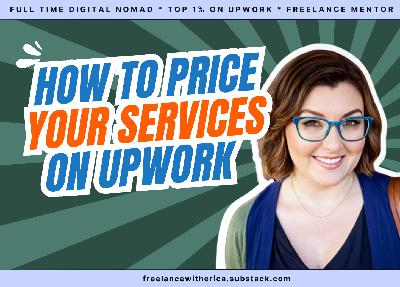
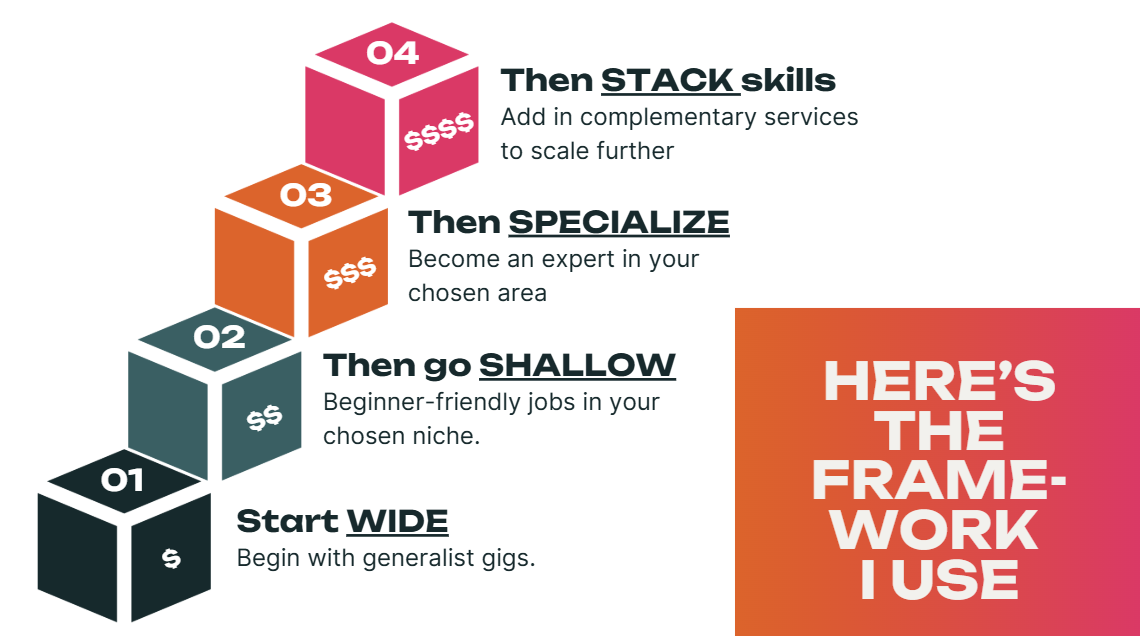
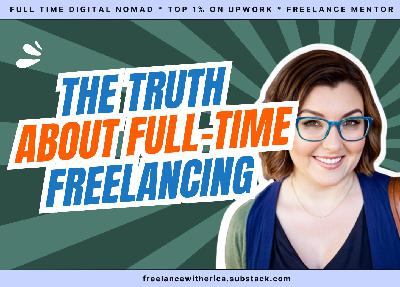
![The "Why Isn't Anyone Responding?!" to My Upwork Proposals [FREE CHECKLIST] The "Why Isn't Anyone Responding?!" to My Upwork Proposals [FREE CHECKLIST]](https://s3.castbox.fm/8f/02/f3/3f9530992ccf57f8fbe086f721d6783290_scaled_v1_400.jpg)

